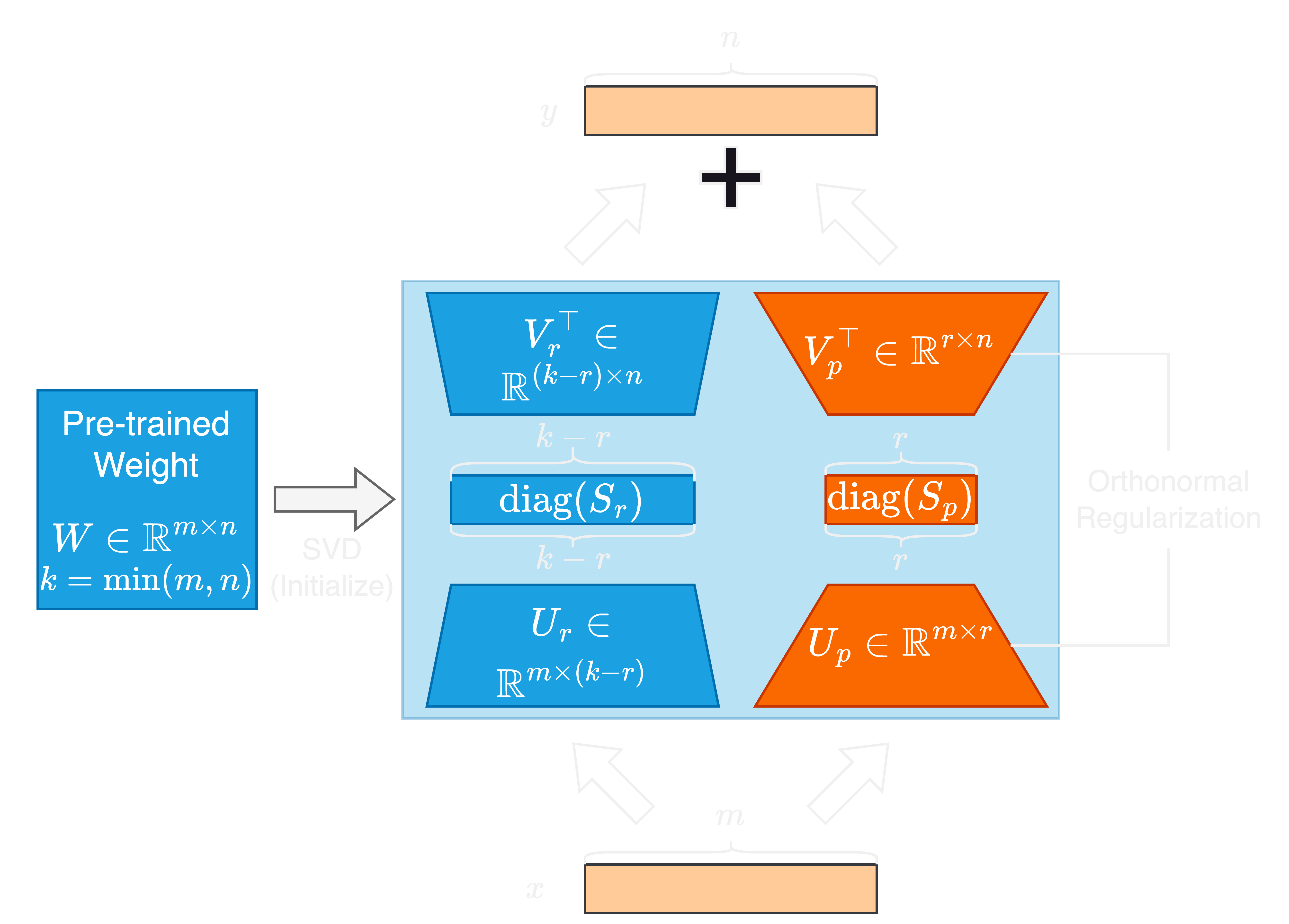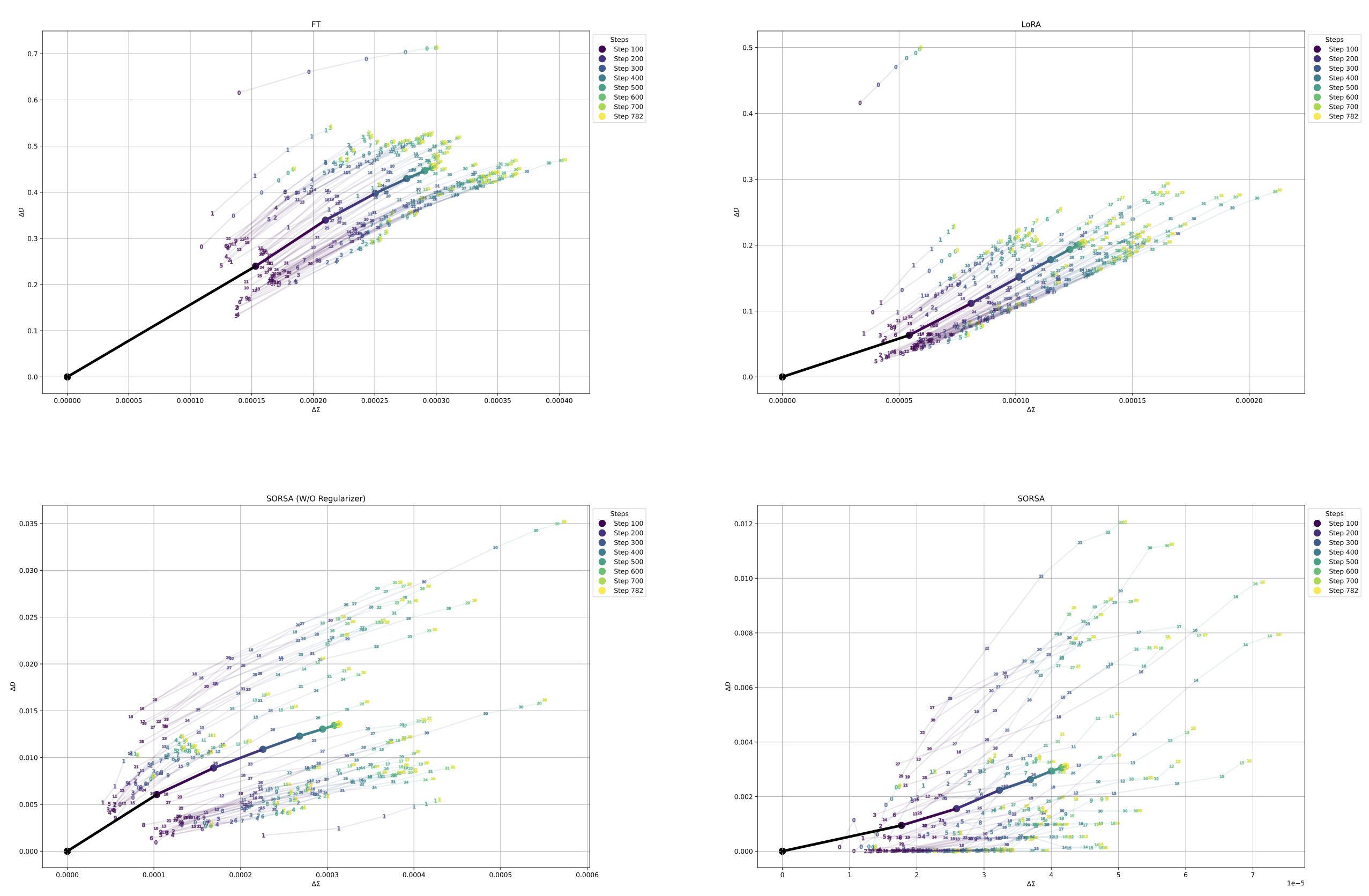See the original paper on arXiv.
Introduction #
As large language models (LLMs) continue to grow in scale, fine-tuning them for specific tasks becomes increasingly expensive. Parameter-Efficient Fine-Tuning (PEFT) methods like LoRA have emerged as practical alternatives, but they face a critical challenge: catastrophic forgetting and overfitting in low-data regimes. When you fine-tune a model on mathematical problems, it might forget how to generate code or reason about common sense.
SORSA (Singular Values and Orthonormal Regularized Singular Vectors Adaptation) addresses this problem through a novel insight: maintaining well-conditioned weight matrices during training is crucial for preserving the model’s generalization capabilities.
Key Innovation #
SORSA’s main contribution is an orthonormal regularizer that keeps singular vectors orthonormal during training. This seemingly simple addition has profound effects:
- Better convergence: SORSA converges faster than LoRA and PiSSA
- Improved generalization: Less catastrophic forgetting of pre-trained knowledge
- Superior performance: On GSM-8K, Llama 2 7B with SORSA achieved 56.03% accuracy vs. LoRA’s 42.30% and even Full Fine-Tuning’s 49.05%
Background: Why Condition Numbers Matter #
The condition number \(\kappa(W)\) of a weight matrix measures how sensitive the matrix is to perturbations:
\[ \kappa(W) = \frac{\sigma_{\max}(W)}{\sigma_{\min}(W)} \]where \(\sigma_{\max}\) and \(\sigma_{\min}\) are the largest and smallest singular values.
Well-conditioned matrices (small \(\kappa\)) lead to:
- Stable gradient flow
- Better optimization landscapes
- Preserved generalization from pre-training
Ill-conditioned matrices (large \(\kappa\)) cause:
- Unstable training
- Catastrophic forgetting
- Poor generalization
Previous research has shown that neural networks with well-conditioned weights provide more robust performance. SORSA explicitly maintains this property during fine-tuning.
SORSA Architecture #
SORSA begins with Singular Value Decomposition (SVD) of the pre-trained weight \(W_0\):
\[ W_0 = U\Sigma V^\top \]The weight is then split into two components:
-
Principal weight \(W_p\) (trainable):
\[ W_p = U_p \cdot \text{diag}(S_p) \cdot V_p^\top \] -
Residual weight \(W_r\) (frozen):
\[ W_r = U_r \cdot \text{diag}(S_r) \cdot V_r^\top \]
where the first \(r\) singular values go to \(W_p\) and the remaining go to \(W_r\).

Key difference from PiSSA: While PiSSA merges the singular values into the matrices (\(A = U_p S_p^{1/2}\), \(B = S_p^{1/2} V_p^\top\)), SORSA keeps \(U_p\), \(S_p\), and \(V_p^\top\) separate. This separation enables the orthonormal regularizer to work effectively.
The Orthonormal Regularizer #
SORSA’s secret sauce is the orthonormal regularizer:
\[ \mathcal{L}_{\text{reg}}(U_p, V_p) = \|U_p^\top U_p - I_m\|_F^2 + \|V_p^\top V_p - I_n\|_F^2 \]This regularizer penalizes deviation from orthonormality, encouraging \(U_p\) and \(V_p\) to remain orthonormal throughout training.
Training Update Rule #
The complete update at training step \(t\) is:
\[ W_{p,t+1} = W_{p,t} - \eta_t \nabla_{W_{p,t}} \mathcal{L}_{\text{train}} - \gamma_t \nabla_{W_{p,t}} \mathcal{L}_{\text{reg}} \]where:
- \(\eta_t\): learning rate for task loss
- \(\gamma_t\): learning rate for regularizer
- In practice, implemented as: \(\gamma_t = \frac{\gamma}{\eta_d} \eta_t\) where \(\eta_d\) is the maximum learning rate
Theoretical Analysis #
Convergence Guarantees #
Theorem (Linear Convergence): Under standard smoothness and strong convexity assumptions, SORSA with gradient descent converges linearly to the optimum:
\[ F(W_p^t) - F(W_p^*) \leq \left(1 - \frac{\mu_{\text{train}} - \gamma C_{\text{reg}}}{L_{\text{train}} + \gamma L_{\text{reg}}}\right)^t (F(W_p^0) - F(W_p^*) \]This theoretical guarantee explains SORSA’s fast convergence in practice.
Condition Number Reduction #
Theorem (Improved Conditioning): At every training iteration \(t\), the condition number of the regularized weight is strictly better than without regularization:
\[ \kappa(W_p^{\text{reg},t}) < \kappa(W_p^{\text{unreg},t}) \]Proof sketch:
- The regularizer drives \(U_p\) and \(V_p\) toward orthonormality, reducing \(\kappa(U_p)\) and \(\kappa(V_p)\)
- Singular values are only slightly perturbed (by Weyl’s inequality)
- Since \(\kappa(W) \leq \kappa(U)\kappa(\Sigma)\kappa(V)\), the overall condition number improves
This is the mathematical foundation for why SORSA preserves pre-trained knowledge better than other methods.
Experimental Analysis: What Changes During Fine-Tuning? #
The paper introduces a novel analysis methodology to understand how fine-tuning affects the model’s internal structure:
Metrics #
Singular Value Deviation:
\[ \Delta\Sigma_t = \frac{1}{k} \sum_{i=1}^k |\sigma_i^t - \sigma_i^0| \]Singular Vector Deviation:
\[ \Delta D_t = 1 - \frac{1}{2k} \sum_{i=1}^k (|\langle u_i^t, u_i^0 \rangle| + |\langle v_i^t, v_i^0 \rangle|) \]Key Findings #

SORSA vs. LoRA/PiSSA:
- LoRA and partial FT: Show large \(\Delta D\) (substantial disruption to singular vectors), indicating significant damage to pre-trained structure
- PiSSA: Similar patterns to LoRA, with parallel updating across layers
- SORSA: Dramatically smaller changes in both \(\Delta\Sigma\) and \(\Delta D\), with non-parallel, layer-specific updates
Interpretation: SORSA makes precise, targeted modifications while preserving the fundamental structure encoding the model’s general knowledge. The orthonormal regularizer acts as a constraint that prevents destructive changes to the weight matrices.
Experimental Results #
Natural Language Generation Tasks #
Training setup:
- Models: Llama 2 7B, RWKV6 7B, Mistral 7B, Gemma 7B
- Dataset: MetaMathQA (100K samples) → Evaluation on GSM-8K, MATH
- Code: CodeFeedback (100K samples) → Evaluation on HumanEval
Performance Comparison #
| Model | Method | GSM-8K | MATH | HumanEval |
|---|---|---|---|---|
| Llama 2 7B | Full FT | 49.05% | 7.22% | 21.34% |
| LoRA | 42.30% | 5.50% | 18.29% | |
| PiSSA | 53.07% | 7.44% | 21.95% | |
| AdaLoRA | 47.30% | 6.48% | 19.51% | |
| SORSA | 56.03% | 10.36% | 24.39% | |
| RWKV6 7B | LoRA | 8.04% | 7.38% | 15.24% |
| PiSSA | 32.07% | 9.42% | 17.07% | |
| AdaLoRA | 33.28% | 8.08% | 15.85% | |
| SORSA | 45.87% | 11.32% | 22.56% | |
| Mistral 7B | Full FT | 67.02% | 18.60% | 45.12% |
| LoRA | 67.70% | 19.68% | 43.90% | |
| PiSSA | 72.86% | 21.54% | 46.95% | |
| AdaLoRA | 72.25% | 21.06% | 45.73% | |
| SORSA | 73.09% | 21.86% | 47.56% |
Key Observations #
- Llama 2 7B: SORSA shows the most dramatic improvements, outperforming even full fine-tuning by 7% on GSM-8K
- RWKV6 7B: SORSA achieves 45.87% vs. LoRA’s catastrophic 8.04%, demonstrating robust learning
- Gradient norms: SORSA maintains more consistent gradient norm reduction compared to LoRA and PiSSA, especially after ~300 training steps
Training Dynamics #
The loss curves reveal interesting behavior:
- Early training (0-300 steps): SORSA and PiSSA perform similarly
- Late training (300+ steps): SORSA continues to decrease loss while LoRA/PiSSA plateau
- Explanation: The orthonormal regularizer creates a better optimization landscape that sustains learning
Why SORSA Works: The Full Picture #
- SVD-based initialization: Starts from a meaningful decomposition of pre-trained weights
- Separate components: Keeping \(U_p\), \(S_p\), \(V_p^\top\) separate (vs. merged in PiSSA) enables effective regularization
- Orthonormal regularizer: Maintains well-conditioned matrices → stable optimization → preserved generalization
- Targeted adaptation: Makes precise, layer-specific modifications rather than broad destructive changes
Practical Considerations #
Advantages:
- ✅ No inference latency (adapters can be merged)
- ✅ ~80% VRAM reduction compared to full fine-tuning
- ✅ Faster convergence than LoRA/PiSSA
- ✅ Better generalization and less catastrophic forgetting
- ✅ Simple to implement
Hyperparameters:
- Rank \(r\): 64-128 (similar to LoRA)
- Regularizer weight \(\gamma\): 4e-4 to 5e-4
- Learning rate: Slightly higher than LoRA (3e-5 vs. 2e-5) to counterbalance regularizer
Implementation #
The code for SORSA is open-sourced:
Conclusion #
SORSA represents a significant advancement in parameter-efficient fine-tuning by:
- Identifying condition number as a critical factor in PEFT
- Introducing an orthonormal regularizer to maintain well-conditioned weights
- Providing theoretical guarantees on convergence and conditioning
- Demonstrating substantial empirical improvements across multiple models and tasks
The key insight—that preserving the geometric structure of pre-trained weights through orthonormal regularization leads to better adaptation—opens new directions for future PEFT research.
Citation #
@article{cao2024sorsa,
title={SORSA: Singular Values and Orthonormal Regularized Singular Vectors Adaptation of Large Language Models},
author={Cao, Yang and Song, Zhao},
journal={arXiv preprint arXiv:2409.00055},
year={2024}
}
